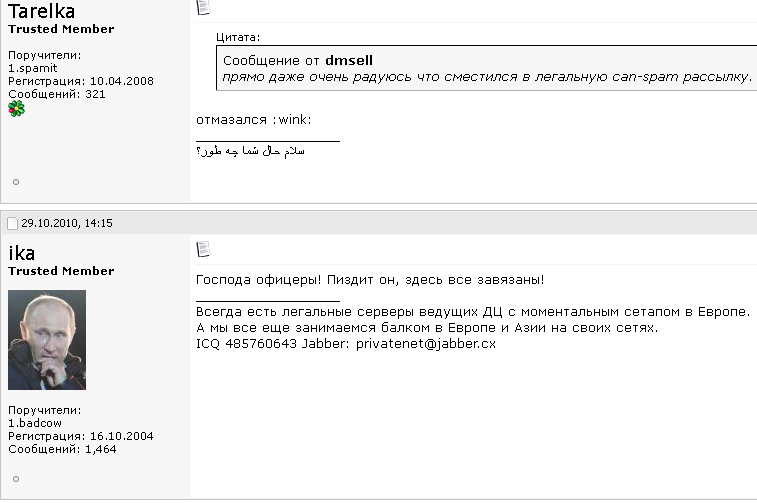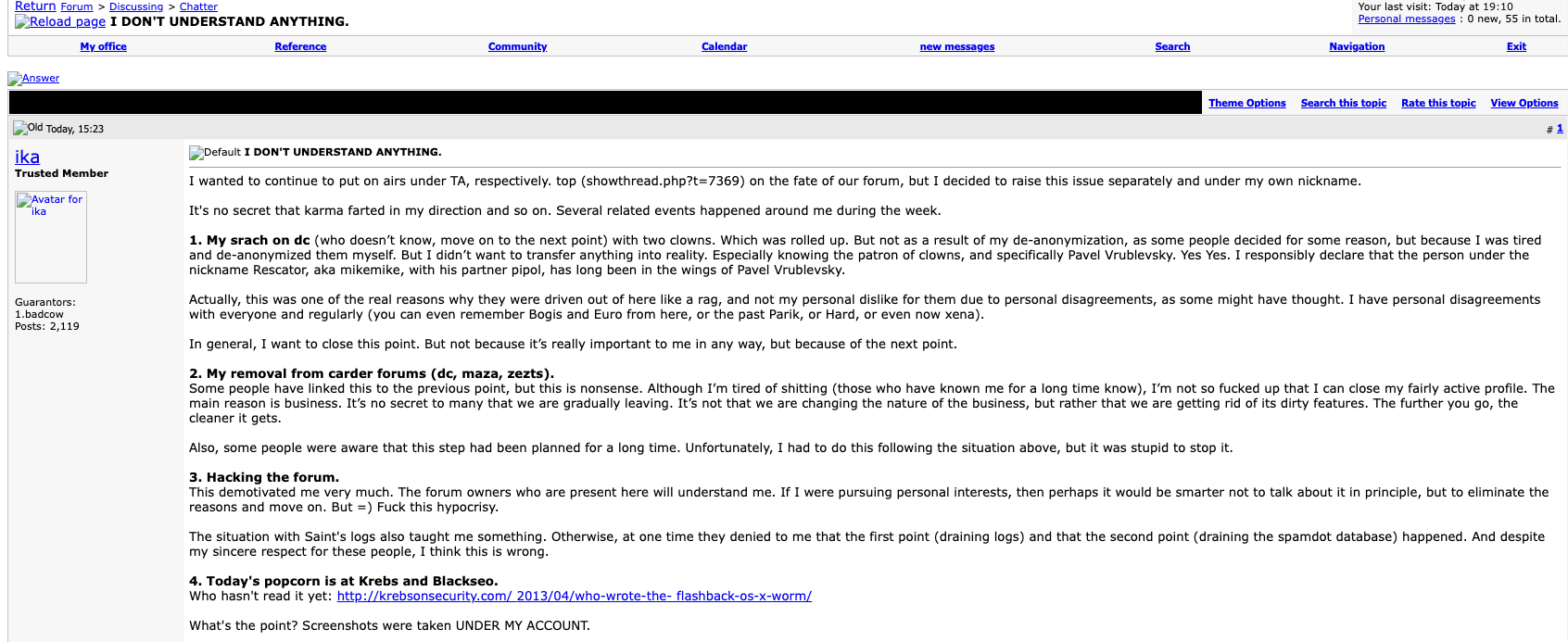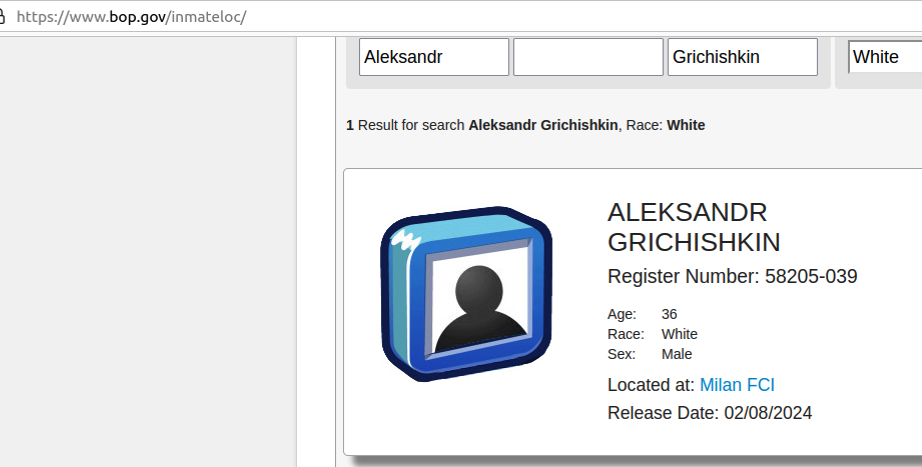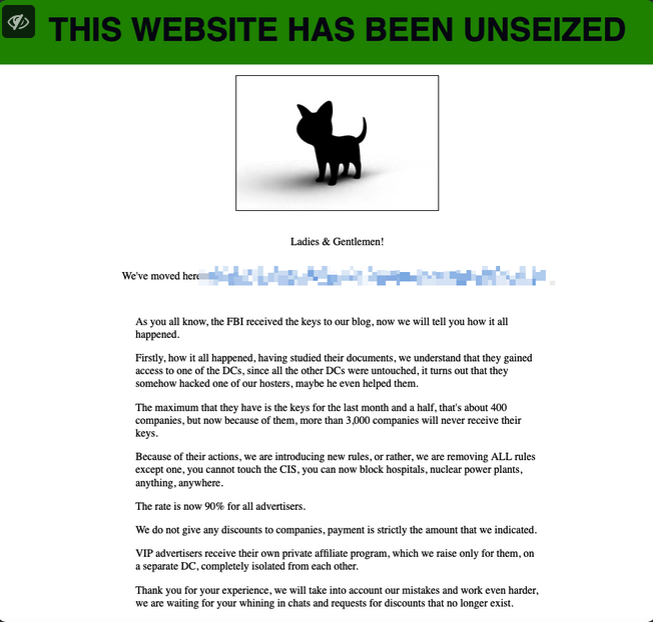A California man who lost $100,000 in a 2021 SIM-swapping attack is suing the unknown holder of a cryptocurrency wallet that harbors his stolen funds. The case is thought to be the first in which a federal court has recognized the use of information included in a bitcoin transaction — such as a link to a civil claim filed in federal court — as reasonably likely to provide notice of the lawsuit to the defendant. Experts say the development could make it easier for victims of crypto heists to recover stolen funds through the courts without having to wait years for law enforcement to take notice or help.

Ryan Dellone, a healthcare worker in Fresno, Calif., asserts that thieves stole his bitcoin on Dec. 14, 2021, by executing an unauthorized SIM-swap that involved an employee at his mobile phone provider who switched Dellone’s phone number over to a new device the attackers controlled.
Dellone says the crooks then used his phone number to break into his account at Coinbase and siphon roughly $100,000 worth of cryptocurrencies. Coinbase is also named as a defendant in the lawsuit, which alleges the company ignored multiple red flags, and that it should have detected and stopped the theft. Coinbase did not respond to requests for comment.
Working with experts who track the flow of funds stolen in cryptocurrency heists, Dellone’s lawyer Ethan Mora identified a bitcoin wallet that was the ultimate destination of his client’s stolen crypto. Mora says his client has since been made aware that the bitcoin address in question is embroiled in an ongoing federal investigation into a cryptocurrency theft ring.
Mora said it’s unclear if the bitcoin address that holds his client’s stolen money is being held by the government or by the anonymous hackers. Nevertheless, he is pursuing a novel legal strategy that allows his client to serve notice of the civil suit to that bitcoin address — and potentially win a default judgment to seize his client’s funds within — without knowing the identity of his attackers or anything about the account holder.
In a civil lawsuit seeking monetary damages, a default judgment is usually entered on behalf of the plaintiff if the defendant fails to respond to the complaint within a specified time. Assuming that the cybercriminals who stole the money don’t dispute Dellone’s claim, experts say the money could be seized by cryptocurrency exchanges if the thieves ever tried to move it or spend it.
The U.S. courts have generally held that if you’re going to sue someone, you have to provide some kind of meaningful and timely communication about that lawsuit to the defendant in a way that is reasonably likely to provide them notice.
Not so long ago, you had track down your defendant and hire someone to physically serve them with a copy of the court papers. But legal experts say the courts have evolved their thinking in recent years about what constitutes meaningful service, and now allow notification via email.
On Dec. 14, 2023, a federal judge in the Eastern District of California granted Dellone permission to serve notice of his lawsuit directly to the suspected hackers’ bitcoin address — using a short message that was attached to roughly $100 worth of bitcoin Mora sent to the address.
Bitcoin transactions are public record, and each transaction can be sent along with an optional short message. The message uses what’s known as an “OP RETURN,” or an instruction of the Bitcoin scripting language that allows users to attach metadata to a transaction — and thus save it on the blockchain.
In the $100 bitcoin transaction Mora sent to the disputed bitcoin address, the OP RETURN message read: “OSERVICE – SUMMONS, COMPLAINT U.S. Dist. E.D. Cal. LINK: t.ly/123cv01408_service,” which is a short link to a copy of the lawsuit hosted on Google Drive.
“The courts are adapting to the new style of service of process,” said Mark Rasch, a former federal prosecutor at the U.S. Department of Justice. “And that’s helpful and useful and necessary.”
Rasch said Mora’s strategy could force the government to divulge information about their case, or else explain to a judge why the plaintiff shouldn’t be able to recover their stolen funds without further delay. Rasch said it could be that Dellone’s stolen crypto was seized as part of a government asset forfeiture, but that either way there is no reason Uncle Sam should hold some cybercrime victims’ life savings indefinitely.
“The government doesn’t need the crypto as evidence, but in a forfeiture action the money goes to the government,” Rasch said. “But it was never the government’s money, and that doesn’t help the victim. The government should be providing information to the victims of cryptocurrency theft so that their attorneys can go get the money back themselves.”
Nick Bax is a security researcher who specializes in tracing the labyrinthine activity of criminals trying to use cryptocurrency exchanges and other financial instruments to launder the proceeds of cybercrime. Bax said Mora’s method could allow more victims to stake legitimate legal claims to their stolen funds.
“If you get a default judgment against a bitcoin address, for example, and then down the road that bitcoin gets sent to an exchange that complies with or abides by U.S. court orders, then it’s yours,” Bax said. “I’ve seen funds with a court order on them get frozen by the exchanges that decided it made sense to comply with orders from a U.S. federal court.”
Bax’s research was featured in a Sept. 2023 story here about how experts now believe it’s likely hackers are cracking open some of the password vaults stolen in the 2022 data breach at LastPass.
“I’ve talked to a lot victims who have had life-changing amounts of money being seized and would like that money back,” Bax said. “A big goal here is just making civil cases more efficient. Because then people can help themselves and they don’t need to rely solely on law enforcement with its limited resources. And that’s really the goal: To scale this and make it economically viable.”
While Dellone’s lawsuit may be the first time anyone has obtained approval from a federal judge to use bitcoin to notify another party of a civil action, the technique has been used in several recent unrelated cases involving other cryptocurrencies, including Ethereum and NFTs.
The law firm DLAPiper writes that in November 2022, the U.S. District Court for the Southern District of Florida “authorized service of a lawsuit seeking the recovery of stolen digital assets by way of a non-fungible token or NFT containing the text of the complaint and summons, as well as a hyperlink to a website created by the plaintiffs containing all pleadings and orders in the action.”
In approving Dellone’s request for service via bitcoin transaction, the judge overseeing the case cited a recent New York Superior Court ruling in a John Doe case brought by victims seeking to unmask the crooks behind a $1.3 million cyberheist.
In the New York case, the state trial court found it was acceptable for the plaintiffs to serve notice of the suit via cryptocurrency transactions because the defendants regularly used the Blockchain address to which the tokens were sent, and had recently done so. Also, the New York court found that because the account in question contained a significant sum of money, it was unlikely to be abandoned or forgotten.
“Thus the court inferred the defendants were likely to access the account in the future,” wrote Judge Helena M. March-Kuchta, for the Eastern District of California, summarizing the New York case. “Finally, the plaintiff had no alternative means of contacting these unknown defendants.”
Experts say regardless of the reason for a cryptocurrency theft or loss — whether it’s from a romance scam or a straight-up digital mugging — it’s important for victims to file an official report both with their local police and with the FBI’s Internet Crime Complaint Center (ic3.gov). The IC3 collects reports on cybercrime and sometimes bundles victim reports into cases for DOJ/FBI prosecutors and investigators.
The hard truth is that most victims will never see their stolen funds again. But sometimes federal investigators win minor victories and manage to seize or freeze crypto assets that are known to be associated with specific crimes and criminals. In those cases, the government will eventually make an effort to find, contact and in some cases remunerate known victims.
It might take many years for this process to unfold. But if and when they do make that effort, federal investigators are likely to focus their energies and attention responding to victims who staked a claim and can support it with documentation.
But have no illusions that any of this is likely to happen in a timeframe that is meaningful to victims in the short run. For example, in 2013 the U.S. government seized the assets of the virtual currency Liberty Reserve, massively disrupting a major vehicle for laundering the proceeds of cybercrime and other illegal activities.
When the government offered remuneration to Liberty Reserve account holders who wished to make a financial loss claim and supply supporting documentation, KrebsOnSecurity filed a claim. There wasn’t money much in my Liberty Reserve account; I simply wanted to know how long it would take for federal investigators to follow up on my claim, or indeed if they would at all.
In 2020 KrebsOnSecurity was contacted by an investigator with the U.S. Internal Revenue Service (IRS) who was seeking to discuss my claim. The investigator said they would have called sooner, but that it had taken that long for the IRS to gain legal access to the funds seized in the 2013 Liberty Reserve takedown.
In 2020, the United States brought charges against four men accused of building a bulletproof hosting empire that once dominated the Russian cybercrime industry and supported multiple organized cybercrime groups. All four pleaded guilty to conspiracy and racketeering charges. But there is a fascinating and untold backstory behind the two Russian men involved, who co-ran the world’s top spam forum and worked closely with Russia’s most dangerous cybercriminals.
From January 2005 to April 2013, there were two primary administrators of the cybercrime forum Spamdot (a.k.a Spamit), an invite-only community for Russian-speaking people in the businesses of sending spam and building botnets of infected computers to relay said spam. The Spamdot admins went by the nicknames Icamis (a.k.a. Ika), and Salomon (a.k.a. Sal).

Spamdot forum administrator “Ika” a.k.a. “Icamis” responds to a message from “Tarelka,” the botmaster behind the Rustock botnet. Dmsell said: “I’m actually very glad that I switched to legal spam mailing,” prompting Tarelka and Ika to scoff.
As detailed in my 2014 book, Spam Nation, Spamdot was home to crooks controlling some of the world’s nastiest botnets, global malware contagions that went by exotic names like Rustock, Cutwail, Mega-D, Festi, Waledac, and Grum.
Icamis and Sal were in daily communications with these botmasters, via the Spamdot forum and private messages. Collectively in control over millions of spam-spewing zombies, those botmasters also continuously harvested passwords and other data from infected machines.
As we’ll see in a moment, Salomon is now behind bars, in part because he helped to rob dozens of small businesses in the United States using some of those same harvested passwords. He is currently housed in a federal prison in Michigan, serving the final stretch of a 60-month sentence.
But the identity and whereabouts of Icamis have remained a mystery to this author until recently. For years, security experts — and indeed, many top cybercriminals in the Spamit affiliate program — have expressed the belief that Sal and Icamis were likely the same person using two different identities. And there were many good reasons to support this conclusion.
For example, in 2010 Spamdot and its spam affiliate program Spamit were hacked, and its user database shows Sal and Icamis often accessed the forum from the same Internet address — usually from Cherepovets, an industrial town situated approximately 230 miles north of Moscow. Also, it was common for Icamis to reply when Spamdot members communicated a request or complaint to Sal, and vice versa.

Image: maps.google.com
Still, other clues suggested Icamis and Sal were two separate individuals. For starters, they frequently changed the status on their instant messenger clients at different times. Also, they each privately discussed with others having attended different universities.
KrebsOnSecurity began researching Icamis’s real-life identity in 2012, but failed to revisit any of that research until recently. In December 2023, KrebsOnSecurity published new details about the identity of “Rescator,” a Russian cybercriminal who is thought to be closely connected to the 2013 data breach at Target.
That story mentioned Rescator’s real-life identity was exposed by Icamis in April 2013, as part of a lengthy farewell letter Ika wrote to Spamdot members wherein Ika said he was closing the forum and quitting the cybercrime business entirely.
To no one’s shock, Icamis didn’t quit the business: He simply became more quiet and circumspect about his work, which increasingly was focused on helping crime groups siphon funds from U.S. bank accounts. But the Rescator story was a reminder that 10 years worth of research on who Ika/Icamis is in real life had been completely set aside. This post is an attempt to remedy that omission.

The farewell post from Ika (aka Icamis), the administrator of both the BlackSEO forum and Pustota, the successor forum to Spamit/Spamdot.
Icamis and Sal offered a comprehensive package of goods and services that any aspiring or accomplished spammer would need on a day-to-day basis: Virtually unlimited bulletproof domain registration and hosting services, as well as services that helped botmasters evade spam block lists generated by anti-spam groups like Spamhaus.org. Here’s snippet of Icamis’s ad on Spamdot from Aug. 2008, wherein he addresses forum members with the salutation, “Hello Gentlemen Scammers.”
We are glad to present you our services!
Many are already aware (and are our clients), but publicity is never superfluous.Domains.
– all major gtlds (com, net, org, info, biz)
– many interesting and uninteresting cctlds
– options for any topic
– processing of any quantities
– guarantees
– exceptionally low prices for domains for white and gray schemes (including any SEO and affiliate spam )
– control panel with balances and auto-registration
– all services under the Ikamis brand, proven over the years;)Servers.
– long-term partnerships with several [data centers] in several parts of the world for any topic
– your own data center (no longer in Russia ;)) for gray and white topics
– any configuration and any hardware
– your own IP networks (PI, not PA) and full legal support
– realtime backups to neutral sites
– guarantees and full responsibility for the services provided
– non-standard equipment on request
– our own admins to resolve any technical issues (services are free for clients)
– hosting (shared and vps) is also possibleNon-standard and related services.
– ssl certificates signed by geotrust and thawte
– old domains (any year, any quantity)
– beautiful domains (keyword, short, etc.)
– domains with indicators (any, for SEO, etc.)
– making unstable gtld domains stable
– interception and hijacking of custom domains (expensive)
– full domain posting via web.archive.org with restoration of native content (preliminary applications)
– any updates to our panels to suit your needs upon request (our own coders)All orders for the “Domains” sections and “Servers” are carried out during the day (depending on our workload).
For non-standard and related services, a preliminary application is required 30 days in advance (except for ssl certificates – within 24 hours).
Icamis and Sal frequently claimed that their service kept Spamhaus and other anti-spam groups several steps behind their operations. But it’s clear that those anti-spam operations had a real and painful impact on spam revenues, and Salomon was obsessed with striking back at anti-spam groups, particularly Spamhaus.
In 2007, Salomon collected more than $3,000 from botmasters affiliated with competing spam affiliate programs that wanted to see Spamhaus suffer, and the money was used to fund a week-long distributed denial-of-service (DDoS) attack against Spamhaus and its online infrastructure. But rather than divert their spam botnets from their normal activity and thereby decrease sales, the botmasters voted to create a new DDoS botnet by purchasing installations of DDoS malware on thousands of already-hacked PCs (at a rate of $25 per 1,000 installs).
As an affiliate of Spamdot, Salomon used the email address ad1@safe-mail.net, and the password 19871987gr. The breach tracking service Constella Intelligence found the password 19871987gr was used by the email address grichishkin@gmail.com. Multiple accounts are registered to that email address under the name Alexander Valerievich Grichishkin, from Cherepovets.
In 2020, Grichishkin was arrested outside of Russia on a warrant for providing bulletproof hosting services to cybercriminal gangs. The U.S. government said Grichishkin and three others set up the infrastructure used by cybercriminals between 2009 to 2015 to distribute malware and attack financial institutions and victims throughout the United States.
Those clients included crooks using malware like Zeus, SpyEye, Citadel and the Blackhole exploit kit to build botnets and steal banking credentials.
“The Organization and its members helped their clients to access computers without authorization, steal financial information (including banking credentials), and initiate unauthorized wire transfers from victims’ financial accounts,” the government’s complaint stated.
Grichishkin pleaded guilty to conspiracy charges and was sentenced to four years in prison. He is 36 years old, has a wife and kids in Thailand, and is slated for release on February 8, 2024.

The identity of Icamis came into view when KrebsOnSecurity began focusing on clues that might connect Icamis to Cherepovets (Ika’s apparent hometown based on the Internet addresses he regularly used to access Spamdot).
Historic domain ownership records from DomainTools.com reveal that many of the email addresses and domains connected to Icamis invoke the name “Andrew Artz,” including icamis[.]ws, icamis[.]ru, and icamis[.]biz. Icamis promoted his services in 2003 — such as bulk-domains[.]info — using the email address icamis@4host.info. From one of his ads in 2005:
Domains For Projects Advertised By Spam
I can register bulletproof domains for sites and projects advertised by spam(of course they must be legal). I can not provide DNS for u, only domains. The price will be:
65$ for domain[if u will buy less than 5 domains]
50$ for domain[more than 5 domains]
45$ for domain[more than 10 domains]
These prices are for domains in the .net & .com zones.
If u want to order domains write me to: icamis@4host.info
In 2009, an “Andrew Artz” registered at the hosting service FirstVDS.com using the email address icamis@4host.info, with a notation saying the company name attached to the account was “WMPay.” Likewise, the bulletproof domain service icamis[.]ws was registered to an Andrew Artz.
The domain wmpay.ru is registered to the phonetically similar name “Andrew Hertz,” at andrew@wmpay.ru. A search on “icamis.ru” in Google brings up a 2003 post by him on a discussion forum designed by and for students of Amtek, a secondary school in Cherepovets (Icamis was commenting from an Internet address in Cherepovets).

The website amtek-foreva-narod.ru is still online, and it links to several yearbooks for Amtek graduates. It states that the yearbook for the Amtek class of 2004 is hosted at 41.wmpay[.]com.
The yearbook photos for the Amtek class of 2004 are not indexed in the Wayback Machine at archive.org, but the names and nicknames of 16 students remain. However, it appears that the entry for one student — the Wmpay[.]com site administrator — was removed at some point.
In 2004, the administrator of the Amtek discussion forum — a 2003 graduate who used the handle “Grand” — observed that there were three people named Andrey who graduated from Amtek in 2004, but one of them was conspicuously absent from the yearbook at wmpay[.]ru: Andrey Skvortsov.

To bring this full circle, Icamis was Andrey Skvortsov, the other Russian man charged alongside Grichiskin (the two others who pleaded guilty to conspiracy charges were from Estonia and Lithuania). All of the defendants in that case pleaded guilty to conspiracy to engage in a Racketeer Influenced Corrupt Organization (RICO).
[Author’s note: No doubt government prosecutors had their own reasons for omitting the nicknames of the defendants in their press releases, but that information sure would have saved me a lot of time and effort].
Skvortsov was sentenced to time served, and presumably deported. His current whereabouts are unknown and he was not reachable for comment via his known contact addresses.
The government says Ika and Sal’s bulletproof hosting empire provided extensive support for a highly damaging cybercrime group known as the JabberZeus Crew, which worked closely with the author of the Zeus Trojan — Evgeniy Mikhailovich Bogachev — to develop a then-advanced strain of the Zeus malware that was designed to defeat one-time codes for authentication. Bogachev is a top Russian cybercriminal with a standing $3 million bounty on his head from the FBI.
The JabberZeus Crew stole money by constantly recruiting money mules, people in the United States and in Europe who could be enticed or tricked into forwarding money stolen from cybercrime victims. Interestingly, Icamis’s various email addresses are connected to websites for a vast network of phony technology companies that claimed they needed people with bank accounts to help pay their overseas employees.
Icamis used the email address tech@safe-mail.net on Spamdot, and this email address is tied to the registration records for multiple phony technology companies that were set up to recruit money mules.
One such site — sun-technology[.]net — advertised itself as a Hong Kong-based electronics firm that was looking for “honest, responsible and motivated people in UK, USA, AU and NZ to be Sales Representatives in your particular region and receive payments from our clients. Agent commission is 5 percent of total amount received to the personal bank account. You may use your existing bank account or open a new one for these purposes.”
In January 2010, KrebsOnSecurity broke the news that the JabberZeus crew had just used money mules to steal $500,000 from tiny Duanesburg Central School District in upstate New York. As part of his sentence, Skvortsov was ordered to pay $497,200 in restitution to the Duanesburg Central School District.
The JabberZeus Crew operated mainly out of the eastern Ukraine city of Donetsk, which was always pro-Russia and is now occupied by Russian forces. But when Russia invaded Ukraine in February 2022, the alleged leader of the notorious cybercrime gang — Vyacheslav Igoravich Andreev (a.ka. Penchukov) — fled his mandatory military service orders and was arrested in Geneva, Switzerland. He is currently in federal custody awaiting trial, and is slated to be arraigned in U.S. federal court tomorrow (Jan. 9, 2024). A copy of the indictment against Andreev is here (PDF).

Andreev, aka “Tank,” seen here performing as a DJ in Ukraine in an undated photo from social media.

The quantum computing era is coming, and it will change everything about how the world connects online. While quantum computing will yield tremendous benefits, it will also create new risks, so it’s essential that we prepare our critical internet infrastructure for what’s to come. That’s why we’re so pleased to share our latest efforts in this area, including technology that we’re making available as an open source implementation to help internet operators worldwide prepare.
In recent years, the research team here at Verisign has been focused on a future where quantum computing is a reality, and where the general best practices and guidelines of traditional cryptography are re-imagined. As part of that work, we’ve made three further contributions to help the DNS community prepare for these changes:
First, a brief refresher on what MTL mode is and what it accomplishes:
MTL mode is a technique developed by Verisign researchers that can reduce the operational impact of a signature scheme when authenticating an evolving series of messages. Rather than signing messages individually, MTL mode signs structures called Merkle tree ladders that are derived from the messages to be authenticated. Individual messages are authenticated relative to a ladder using a Merkle tree authentication path, while ladders are authenticated relative to a public key of an underlying signature scheme using a digital signature. The size and computational cost of the underlying digital signatures can therefore be spread across multiple messages.
The reduction in operational impact achieved by MTL mode can be particularly beneficial when the mode is applied to a signature scheme that has a large signature size or computational cost in specific use cases, such as when post-quantum signature schemes are applied to DNSSEC.
Recently, Verisign Fellow Duane Wessels described how Verisign’s DNSSEC algorithm update — from RSA/SHA-256 (Algorithm 8) to ECDSA Curve P-256 with SHA-256 (Algorithm 13) — increases the security strength of DNSSEC signatures and reduces their size impact. The present update is a logical next step in the evolution of DNSSEC resiliency. In the future, it is possible that DNSSEC may utilize a post-quantum signature scheme. Among the new post-quantum signature schemes currently being standardized, though, there is a shortcoming; if we were to directly apply these schemes to DNSSEC, it would significantly increase the size of the signatures1. With our work on MTL mode, the researchers at Verisign have provided a way to achieve the security benefit of a post-quantum algorithm rollover in a way that mitigates the size impact.
Put simply, this means that in a quantum environment, the MTL mode of operation developed by Verisign will enable internet infrastructure operators to use the longer signatures they will need to protect communications from quantum attacks, while still supporting the speed and space efficiency we’ve come to expect.
For more background information on MTL mode and how it works, see my July 2023 blog post, the MTL mode I-D, or the research paper, “Merkle Tree Ladder Mode: Reducing the Size Impact of NIST PQC Signature Algorithms in Practice.”
In my July 2023 blog post titled “Next Steps in Preparing for Post-Quantum DNSSEC,” I described two recent contributions by Verisign to help the DNS community prepare for a post-quantum world: the MTL mode I-D and a public, royalty-free license to certain intellectual property related to that I-D. These activities set the stage for the latest contributions I’m announcing in this post today.
Verisign is grateful for the DNS community’s interest in this area, and we are pleased to serve as stewards of the internet when it comes to developing new technology that can help the internet grow and thrive. Our work on MTL mode is one of the longer-term efforts supporting our mission to enhance the security, stability, and resiliency of the global DNS. We’re encouraged by the progress that has been achieved, and we look forward to further collaborations as we prepare for a post-quantum future.
 ︎
︎
The post Verisign Provides Open Source Implementation of Merkle Tree Ladder Mode appeared first on Verisign Blog.
The U.S. Federal Bureau of Investigation (FBI) disclosed today that it infiltrated the world’s second most prolific ransomware gang, a Russia-based criminal group known as ALPHV and BlackCat. The FBI said it seized the gang’s darknet website, and released a decryption tool that hundreds of victim companies can use to recover systems. Meanwhile, BlackCat responded by briefly “unseizing” its darknet site with a message promising 90 percent commissions for affiliates who continue to work with the crime group, and open season on everything from hospitals to nuclear power plants.

A slightly modified version of the FBI seizure notice on the BlackCat darknet site (Santa caps added).
Whispers of a possible law enforcement action against BlackCat came in the first week of December, after the ransomware group’s darknet site went offline and remained unavailable for roughly five days. BlackCat eventually managed to bring its site back online, blaming the outage on equipment malfunctions.
But earlier today, the BlackCat website was replaced with an FBI seizure notice, while federal prosecutors in Florida released a search warrant explaining how FBI agents were able to gain access to and disrupt the group’s operations.
A statement on the operation from the U.S. Department of Justice says the FBI developed a decryption tool that allowed agency field offices and partners globally to offer more than 500 affected victims the ability to restore their systems.
“With a decryption tool provided by the FBI to hundreds of ransomware victims worldwide, businesses and schools were able to reopen, and health care and emergency services were able to come back online,” Deputy Attorney General Lisa O. Monaco said. “We will continue to prioritize disruptions and place victims at the center of our strategy to dismantle the ecosystem fueling cybercrime.”
The DOJ reports that since BlackCat’s formation roughly 18 months ago, the crime group has targeted the computer networks of more than 1,000 victim organizations. BlackCat attacks usually involve encryption and theft of data; if victims refuse to pay a ransom, the attackers typically publish the stolen data on a BlackCat-linked darknet site.
BlackCat formed by recruiting operators from several competing or disbanded ransomware organizations — including REvil, BlackMatter and DarkSide. The latter group was responsible for the Colonial Pipeline attack in May 2021 that caused nationwide fuel shortages and price spikes.
Like many other ransomware operations, BlackCat operates under the “ransomware-as-a-service” model, where teams of developers maintain and update the ransomware code, as well as all of its supporting infrastructure. Affiliates are incentivized to attack high-value targets because they generally reap 60-80 percent of any payouts, with the remainder going to the crooks running the ransomware operation.
BlackCat was able to briefly regain control over their darknet server today. Not long after the FBI’s seizure notice went live the homepage was “unseized” and retrofitted with a statement about the incident from the ransomware group’s perspective.

The message that was briefly on the homepage of the BlackCat ransomware group this morning. Image: @GossiTheDog.
BlackCat claimed that the FBI’s operation only touched a portion of its operations, and that as a result of the FBI’s actions an additional 3,000 victims will no longer have the option of receiving decryption keys. The group also said it was formally removing any restrictions or discouragement against targeting hospitals or other critical infrastructure.
“Because of their actions, we are introducing new rules, or rather, we are removing ALL rules except one, you cannot touch the CIS [a common restriction against attacking organizations in Russia or the Commonwealth of Independent States]. You can now block hospitals, nuclear power plants, anything, anywhere.”
The crime group also said it was setting affiliate commissions at 90 percent, presumably to attract interest from potential affiliates who might otherwise be spooked by the FBI’s recent infiltration. BlackCat also promised that all “advertisers” under this new scheme would manage their affiliate accounts from data centers that are completely isolated from each other.
BlackCat’s darknet site currently displays the FBI seizure notice. But as BleepingComputer founder Lawrence Abrams explained on Mastodon, both the FBI and BlackCat have the private keys associated with the Tor hidden service URL for BlackCat’s victim shaming and data leak site.
“Whoever is the latest to publish the hidden service on Tor (in this case the BlackCat data leak site), will resume control over the URL,” Abrams said. “Expect to see this type of back and forth over the next couple of days.”
The DOJ says anyone with information about BlackCat affiliates or their activities may be eligible for up to a $10 million reward through the State Department’s “Rewards for Justice” program, which accepts submissions through a Tor-based tip line (visiting the site is only possible using the Tor browser).
Further reading: CISA StopRansomware Alert on the tools, techniques and procedures used by ALPHV/BlackCat.